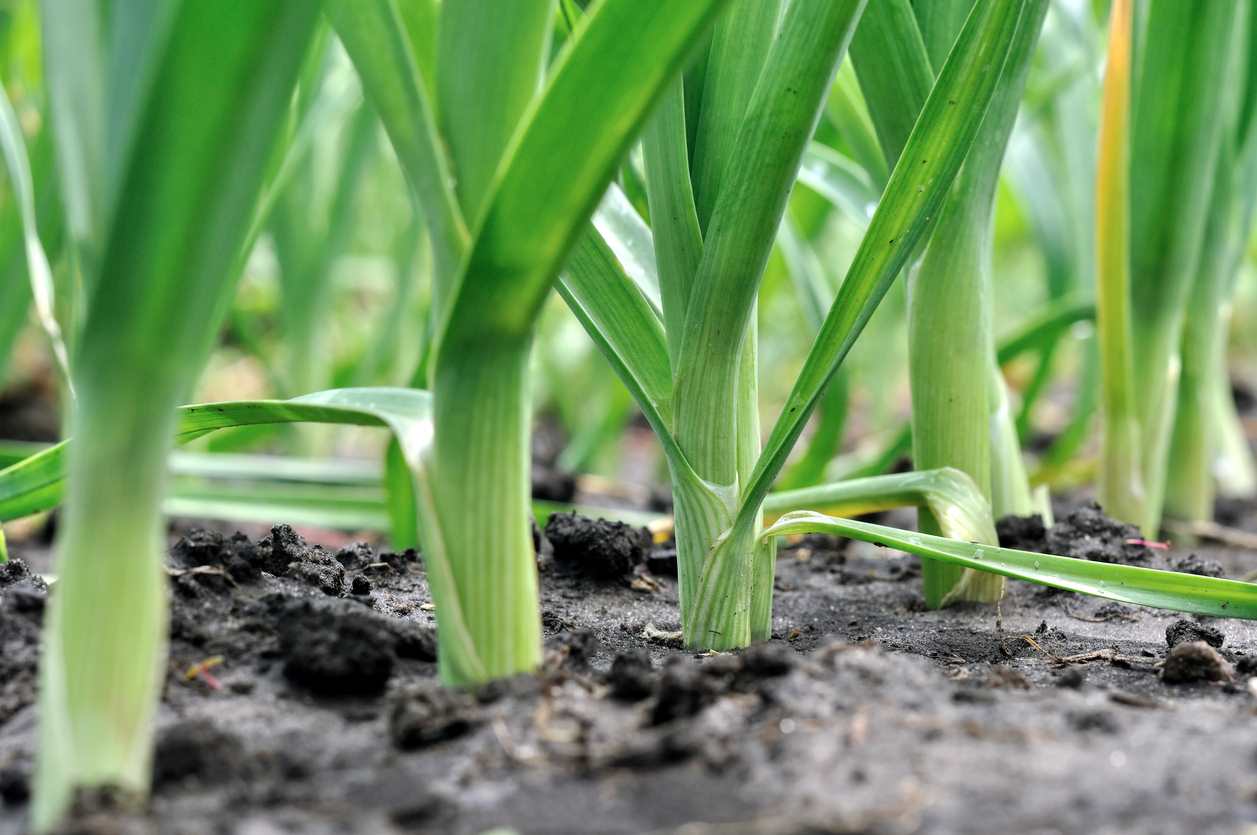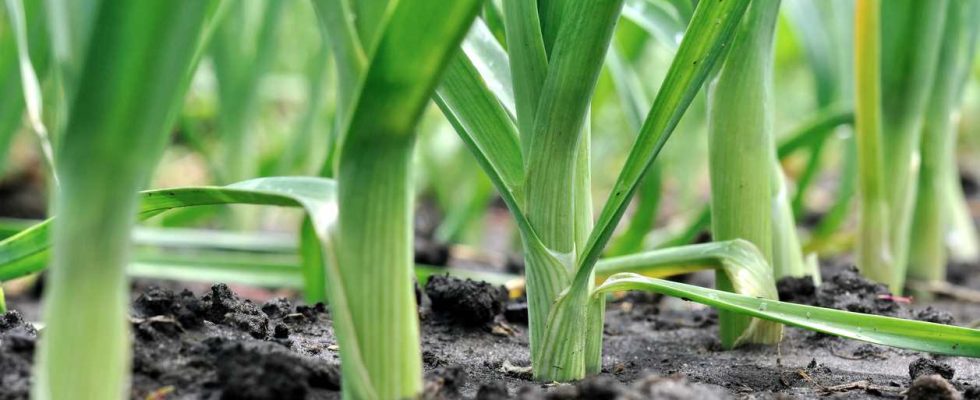
A little spotlight on leek
Learn more about leeks
From the Alliaceae family, the leek, whose scientific name is Allium porrum, is also called “poor man’s asparagus”. At its base, on the buried part, white, sheathed and interlocking leaves constitute a false stem called a “stem”, then rise like a fan out of the ground, green and slightly drooping.
The leaves are the part consumed. They are low in calories, but rich in fiber, in mineral salts, such as calcium, sodium, iron, in trace elements, such as zinc, copper, etc., and in vitamins A, B, and C. With its diuretic properties, expectorant and emollient properties must be added. As a general rule, leek is eaten cooked, whether alone in vinaigrette, or as an accompaniment to meat or fish, or integrated into the preparation of quiches, stews, gratins, etc.
Leek varieties
This very rustic leafy vegetable comes in different varieties including Géant d’hiver 2, yellow gros du Poitou, Bleu de Solaise, etc. The different varieties are differentiated by their taste, the length of the barrel, which can be long, half-long or short, and the cultivation period. Indeed, leeks are classified according to their ability to grow during one season or another, which has the advantage of being able to sow them at different times of the year:
- Summer leeks: They benefit from rapid growth. Due to their precocity, they are mainly grown in the south of France, but they can also be grown elsewhere, provided they are done under a frame. They should be sown between mid-January and February to benefit from a harvest at the end of June.
- Autumn leeks : They benefit from fairly rapid development, but are less hardy. Sowing should be done at the end of spring for a harvest from October.
- Winter leeks : They should be sown between May and June. Thanks to their resistance to cold, they can be harvested from winter until spring.
Leek growing conditions
Here is a summary table of the ideal growing conditions to benefit from good leek harvests.
| Exposure | To grow your leeks, choose a sunny location. But be careful, even if it loves the sun, the leek fears exposure that is too hot and too dry in summer. |
| Ground | It prefers rich, humus, fresh, deep and well-drained soils. Before planting leeks, do not hesitate to incorporate mature compost into the soil. |
| Temperature | If the leek fears excessive heat, it has the ability to withstand temperatures down to -20°C. You can then leave it in the ground throughout the winter. |
| Crop rotation | You must ensure that you cultivate leeks in a growing area that has not grown leeks or other vegetables from the same family for 4 years. |
| Companion plants | You can plant leeks with carrots, because they are mutually beneficial: leeks repel carrot flies, while carrots repel leek moths. You can also grow leeks near strawberries, tomatoes, lamb’s lettuce or asparagus. On the other hand, avoid growing it alongside cabbage, peas or beans. |
Sowing leeks
If it is possible to buy leeks that you will only have to transplant, it is also possible to make your own seedlings.
When should you plant seeds?
You can sow under cover from February. This solution makes it possible to obtain an earlier culture. You can also sow your seeds in the ground from March.
How to proceed ?
There is no need to soak your leek seeds or refrigerate them before planting. The emergence time for leek seeds is between 8 and 20 days. You have the choice between sowing under warm shelter or in the ground.
Early sowing in warmth
To do this, you can use terrines or any other container as long as it is deep enough. Then proceed as follows:
- Install a drainage bed at the bottom of the container.
- Add seedling soil.
- The seeds are very fine, so you have to broadcast them.
- Cover the seeds with a thin layer of soil.
- Moisten using a spray bottle.
- To create a greenhouse effect, you can then place a transparent lid on the container before installing it in a temperate place, because germination occurs between 13 and 24°C.
Sowing in open ground
In this case, remember that the plot used will be monopolized for several months. Here’s how to do it:
- You must first loosen the soil.
- Then prepare furrows, making sure to keep a space of 40 cm between the rows.
- Sow in the furrow. Row sowing makes transplanting work easier.
- Lightly cover the seeds with soil.
- Finally, tamp down a little and water.
- It is then important to ensure that the soil is kept moist until emergence.
Transplanting leeks
Once the young plants from your seedlings have reached the size of a pencil, you can transplant them as follows:
- Take them out of the ground.
- Let them dry for two days in the sun. This has the effect of protecting them from ringworm.
- Cut the roots, as well as the leaves, to leave only a third. This operation, called “dressing”, promotes recovery.
- To finish preparing your young leeks for transplanting, you can praline their roots, but this is not obligatory.
- Dig a furrow about 10 cm deep.
- Place your young leeks in this furrow, leaving a space of 10 cm between each one.
- Finally, water
Interview
To have beautiful leeks, you must, as they grow, provide them with the following care:
- Water frequently : Remember that leeks like cool soils. To meet this need, water in fine rain and abundantly throughout the crop.
- Weed regularly : It is necessary to take particular care in weeding between sowing and transplanting. Indeed, leek being quite slow to develop at the start of cultivation, it is sensitive to invasion by weeds.
- Install mulch : This may be necessary at the end of spring to protect it from the high summer heat and to keep the soil cool.
- Butter : 3 weeks after transplanting, it is useful to hill up gradually to encourage whitening of the barrel.
Harvesting and conservation
The best solution is to harvest leeks as you need them, because the best place to store them during the winter remains open ground. However, if you want to free up the space they occupy, it is possible to harvest them and store them in gauge. This means that you will put them in the ground in a sheltered place, arranging them so that they are close together.
You will be able to keep them for several weeks instead of just a few days if you don’t do this. If you have harvested your leeks and you do not want to store them, you still have the solution of freezing. If, at harvest time, your leeks look frozen, simply let them rest in an unheated room. You can then consume them.
Pests and diseases
Leeks are fairly intolerant of diseases and pests. Here’s what you need to be careful about:
- Rust : This fungus is easily identified by the appearance of rust-colored spots on vegetables. Although this disease does not cause the death of plants, it can harm their development. Some leek varieties are more resistant. Furthermore, by respecting good growing conditions and the principle of crop rotation, you can greatly reduce the risk of disease.
- Avoid too rich manures.
- Leek moth : What should alert you are small holes on the leaves, as well as rust-orange colored galleries. Growing carrots nearby is a good means of prevention. Be careful not to use nettle manure around your leeks, as nettle attracts the leek moth.

